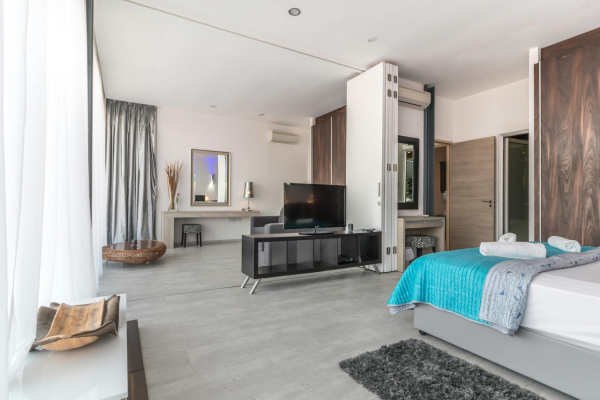Beyond its aesthetic appeal, microcement offers impressive durability and low maintenance, making it a practical choice for modern homes. With a plethora of customisation options, you can tailor microcement to fit your unique vision, while professional installation ensures flawless results. We'll also explore the cost considerations, helping you weigh the investment against long-term benefits. Join us as we uncover the beauty and practicality of microcement walls, offering actionable tips and inspiring examples to guide your next design project.
The Aesthetic Appeal of Microcement in Modern Interiors
When it comes to transforming your living space, nothing beats the visual impact of microcement walls. This innovative material offers a sleek, seamless finish that can elevate any room from ordinary to extraordinary. Imagine walking into a living room where the walls have a smooth, continuous surface that exudes modern elegance. The versatility of microcement allows for a wide range of colour and texture options, making it a perfect fit for various interior styles.
Whether you're a fan of minimalist design or prefer the raw, edgy look of industrial interiors, microcement has got you covered. For instance, in a minimalist setting, the clean lines and neutral tones of microcement walls can create a serene and uncluttered atmosphere. On the other hand, in an industrial-style kitchen, the rough textures and darker shades can add a touch of rugged sophistication. Case studies have shown that microcement is not just a trend but a timeless choice for modern interiors. From living rooms to kitchens and bathrooms, the applications are endless, offering both aesthetic appeal and practical benefits.
Durability and Maintenance - Why Microcement is a Practical Choice
When it comes to interior design, microcement stands out for its exceptional durability and resistance to wear and tear. Unlike traditional materials, microcement can withstand heavy foot traffic, making it an ideal choice for both residential and commercial spaces. Its robust nature ensures that your walls remain pristine for years, even in high-traffic areas.
One of the most appealing aspects of microcement is its low maintenance requirements. Unlike tiles, which often require regular grout cleaning, or wood, which needs periodic polishing and sealing, microcement is virtually maintenance-free. A simple wipe with a damp cloth is usually enough to keep it looking fresh and new. This makes it a practical choice for busy homeowners who want to enjoy beautiful interiors without the hassle of constant upkeep.
- Microcement: Minimal cleaning, no sealing required
- Tiles: Regular grout cleaning, occasional sealing
- Wood: Frequent polishing, periodic sealing
Real-life testimonials from homeowners highlight the benefits of choosing microcement. Jane, a homeowner from London, shares, Switching to microcement was the best decision we made. Our walls look stunning, and the maintenance is a breeze compared to our old tiled walls. Such experiences underscore why microcement is becoming a popular choice in modern interior design.
Customisation Options - Tailoring Microcement to Your Design Needs
When it comes to interior design, the versatility of microcement is unparalleled. This material offers a plethora of customisation possibilities that can transform any space into a unique masterpiece. From a wide range of colours to various textures and finishes, microcement allows you to create bespoke designs that reflect your personal style and preferences.
Imagine a living room with a sleek, polished microcement wall in a deep, rich hue, or a bathroom with a textured, matte finish that adds depth and character. The options are endless, and the results can be truly stunning. Here’s a step-by-step guide to help you work with a designer to achieve your desired look:
- Initial Consultation: Discuss your vision, preferences, and the specific areas you want to transform with microcement.
- Design Proposal: The designer will present a proposal with different colour options, textures, and finishes that align with your vision.
- Sample Creation: Small samples of the proposed designs will be created for your approval.
- Final Design: Once you approve the samples, the designer will finalise the design plan.
- Application: Skilled professionals will apply the microcement, ensuring a flawless finish.
- Review and Touch-ups: After the application, any necessary touch-ups will be made to ensure perfection.
To illustrate the transformative power of microcement, consider a kitchen that went from drab to fab with a custom microcement backsplash. The before-and-after images show a dramatic improvement, highlighting the material's ability to elevate any space. Whether you’re aiming for a modern, industrial look or a warm, rustic feel, microcement can be tailored to meet your design needs, making it a top choice for interior designers and homeowners alike.
Installation Process - What to Expect When Applying Microcement
Embarking on the journey of applying microcement to your walls can be both exciting and daunting. The process involves several meticulous steps that ensure a flawless finish. First, the surface must be thoroughly cleaned and prepared, removing any dust, grease, or loose particles. This step is crucial for the microcement to adhere properly. Next, a primer is applied to create a bonding layer. Following this, the first coat of microcement is spread evenly, and once it dries, it is sanded to achieve a smooth texture. This process is repeated for the second coat, ensuring a robust and durable surface.
Professional installation is paramount for achieving optimal results. Skilled installers have the expertise to handle the material correctly, ensuring an even application and avoiding common pitfalls like cracking or uneven surfaces. The entire process, from preparation to completion, typically spans 3-5 days, depending on the size of the area and the complexity of the design. Homeowners can prepare their space by clearing the area of furniture and covering any fixtures to protect them from dust and debris.
Step | Description | Time Required |
Surface Preparation | Cleaning and priming the surface | 1 day |
First Coat Application | Applying and sanding the first coat of microcement | 1 day |
Second Coat Application | Applying and sanding the second coat of microcement | 1 day |
Final Touches | Sealing and finishing the surface | 1-2 days |
By following these steps and opting for professional installation, homeowners can ensure their microcement walls not only look stunning but also stand the test of time. Proper preparation and skilled application are the keys to unlocking the full potential of this versatile material.
Check: festfloor.com
Cost Considerations - Is Microcement Worth the Investment?
When it comes to interior design, the cost is always a significant factor. Microcement might seem like a premium option, but let's break down the costs associated with it to see if it's truly worth the investment. The initial costs include materials and labour, which can be higher compared to traditional wall finishes. However, the maintenance costs are relatively low, thanks to its durability and resistance to wear and tear. To give you a clearer picture, here's a cost-benefit analysis. While the initial investment in microcement might be higher, the long-term savings are substantial. Unlike other materials that may require frequent repairs or replacements, microcement offers a long-lasting solution. This means fewer expenses over time, making it a cost-effective choice in the long run.
Material | Initial Cost | Maintenance Cost | Long-term Savings |
Microcement | High | Low | High |
Traditional Paint | Low | High | Low |
Wallpaper | Medium | Medium | Medium |
In conclusion, while the initial costs of microcement might be higher, its durability and low maintenance make it a wise investment. If you're looking for a cost-effective and long-lasting wall finish, microcement is definitely worth considering.











